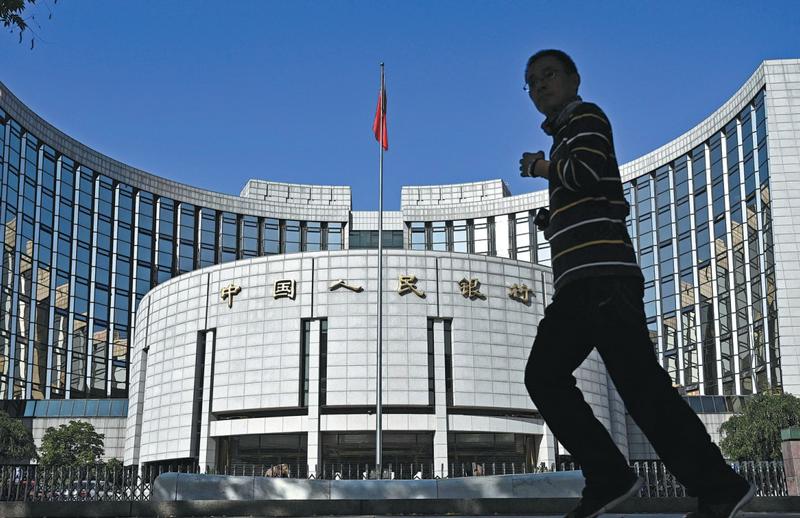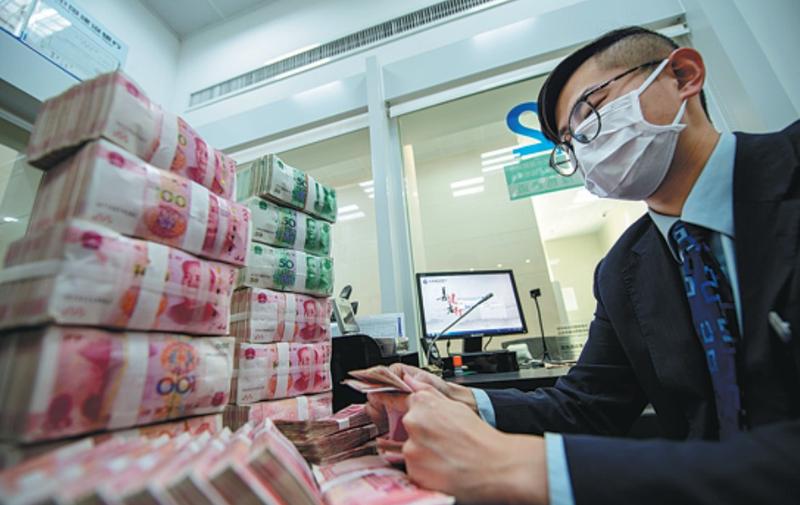Wide range of options open to the PBOC, market players say
 The People's Bank of China aims to keep the RMB exchange rate stable against major currencies amid China's post-pandemic recovery. (ZHANG XINGLONG / CHINA NEWS SERVICE)
The People's Bank of China aims to keep the RMB exchange rate stable against major currencies amid China's post-pandemic recovery. (ZHANG XINGLONG / CHINA NEWS SERVICE)
The central bank is determined to keep the RMB exchange rate stable against a basket of major currencies amid China's post-pandemic recovery, according to economists.
They voiced this view as the RMB's appreciation against the US dollar-a result of China's rapid economic recovery and impressive exports-loses steam, especially after the monetary authority curbed market speculation by withdrawing foreign reserves liquidity.
On Thursday, the RMB fixing rate against the dollar stood at 6.4298, after a national foreign exchange market self-disciplinary mechanism suggested companies take a neutral stance on managing forex risks, as both appreciation and depreciation of the currency is possible. The RMB peaked at 6.3572 per dollar on June 1-the highest level since May, 2018.
In April and last month, the RMB appreciated by more than 3 percent against the dollar and by nearly 1.4 percent against a basket of currencies tracked by the CFETS Index-a pace that fueled concern among monetary authorities. CFETS refers to the China Foreign Exchange Trading system.
Market players said the People's Bank of China, the country's central bank, has various tools it can use to maintain a stable exchange rate. On Tuesday, the bank decided to raise the required reserve ratio on foreign currency deposits in financial institutions-a rare move since the 2008 global financial crisis. This move is expected to reduce the supply of foreign exchange in the market.
Zhang Ming, deputy head of the Institute of Finance and Banking at the Chinese Academy of Social Sciences, or CASS, said other measures are available to the PBOC if the RMB comes under persistent pressure either from appreciation or depreciation.
The measures include open market operations using foreign reserves, and resetting the so-called counter-cyclical factor-the adjustment that contributing banks make to the daily trade-weighted reference rate the central bank uses to guide the RMB.
 A visitor uses e-currency to buy a cup of coffee at the first China International Consumer Products Expo in Haikou, Hainan province, last month. (GUO CHENG / XINHUA)
A visitor uses e-currency to buy a cup of coffee at the first China International Consumer Products Expo in Haikou, Hainan province, last month. (GUO CHENG / XINHUA)
On June 2, China's forex regulator, the State Administration of Foreign Exchange, or SAFE, issued a new quota of US$10.3 billion under the Qualified Domestic Institutional Investor, or QDII, program, allowing 17 Chinese institutional investors to buy more overseas financial instruments.
Analysts said the watchdog took the decision to balance cross-border investment, thus allowing more capital outflows and easing RMB appreciation pressure.
Guan Tao, global chief economist at BOC International and also a former SAFE official, said the QDII quota was the biggest one-off issue in a single month and showed that the authorities are determined to keep the RMB exchange rate at a "reasonable equilibrium".
"We expect the central bank and SAFE to take a series of new measures to achieve balanced cross-border capital flows. These measures might focus on opening the capital account and financial market, especially the stock, bond and foreign exchange markets," Guan said.
Lu Ting, chief China economist at Nomura Securities, said that if these measures were not so effective, the central bank might formulate its own policy actions in coming months.
Analysts said that the monetary authority should avoid any measures to intervene in or manipulate the foreign exchange market, as this would be contrary to market principles and international practices.
Global financial organizations, such as the International Monetary Fund, have consistently confirmed that China is not manipulating the RMB exchange rate.
Iris Pang, chief China economist at Dutch bank ING, said,"The PBOC is sticking to the idea of exchange rate liberalization."
She said the central bank's actions, such as raising the required reserve ratio for foreign deposits, are a way to deter speculation, while guaranteeing the market operates normally.
 A bank clerk checks currency in Hai'an, Jiangsu province. (XU JINGBAI / FOR CHINA DAILY)
A bank clerk checks currency in Hai'an, Jiangsu province. (XU JINGBAI / FOR CHINA DAILY)
Major step
On July 21, 2005, China took a major step with exchange rate reform, shifting from a fixed exchange rate to a more flexible regime. It termed this "a managed floating exchange rate based on market supply and demand with reference to a basket of currencies".
Senior PBOC officials have said the nation will not change the existing exchange rate regime and that the rate is neither a tool to stimulate exports nor a measure to offset the impact of rising commodity prices.
The central bank publishes the fixing rate, or the so-called central parity of onshore-traded RMB against the US dollar, each day. The fixing rate, reached by taking the closing rate on the interbank foreign exchange market the previous day, is offered by all market makers before trading resumes. The final figure is a weighted average of sample offers, excluding the highest and lowest prices.
To further improve the market-based RMB exchange rate regime, the Foreign Exchange Self-Disciplinary Mechanism established by the PBOC and major commercial banks introduced the "countercyclical factor" in the fixing rate's formula in an attempt to offset volatility fueled by market sentiment.
Market players who have tried to predict RMB exchange rates in the short term have found that this becomes increasingly difficult and that they always fail, especially after China introduced foreign exchange reform in August, 2015.
Analysts at financial institutions said that despite the demand-supply relationship in forex trading, market expectations, or investors betting on currency appreciation or depreciation, could play a more significant role in determining spot exchange rates.
Statistics released by SAFE show that from January to April, accumulative foreign exchange settlement and sales by banks stood at US$780.5 billion and US$689.8 billion respectively, producing a surplus of US$90.7 billion.
The figures indicate that more banks wish to hold the RMB in preference to other currencies, in anticipation that it will appreciate.
Louis Kuijs, head of Asia Economics at Oxford Economics, a think tank based in the United Kingdom, said, "Although some people speculated that the authorities might adopt a strong exchange rate policy to counter the impact of high commodity prices, we don't think that is possible."
The latest moves by the PBOC indicate that policymakers have decided not to tolerate additional appreciation and want to avoid further affecting the export-oriented manufacturing sector.
Since the second quarter of this year, the reopening of pandemic-affected sectors in major economies has resulted in mismatches between supply and demand, along with a notable rise in inflation.
Research from Morgan Stanley shows that the rapid recovery of global demand amid unprecedented stimulus packages, coupled with China's robust supply chain, have lifted the nation's exports to a new level in the past two quarters, pushing its global proportion to a record high of 16 percent as of April.
Thanks to its strong exports, China's goods trade surplus rose to US$39.1 billion in April, up from US$18 billion in March, according to SAFE. Zhang, from CASS, said this was one of the key reasons for the RMB's recent appreciation.
Robin Xing, chief China economist at Morgan Stanley, said that in view of projections that China's current account balance will remain above pre-COVID levels this year and next, it is possible that the RMB will appreciate by another 1 percent against a basket of major currencies for the remainder of this year, and by 2 percent next year.
He added that China will continue to open up its market to attract more foreign capital, and the country's inclusion in the FTSE World Government Bond Index from Oct 21 will also bring more investment for the local bond market, supporting a stronger RMB.
 A pedestrian passes screens in Shanghai showing stock market prices. (WANG GANG / FOR CHINA DAILY)
A pedestrian passes screens in Shanghai showing stock market prices. (WANG GANG / FOR CHINA DAILY)
Closer watch
Research from Deutsche Bank predicts that from this year to 2025, about US$590 billion in foreign capital may be injected into China's bond market, and that by 2025, RMB-denominated assets could comprise some 5 percent of global reserves.
The German investment bank said that as the authorities are further opening cross-border capital channels this year, including raising the QDII quota, RMB appreciation momentum will be contained.
Bian Weihong, an analyst with Bank of China, said keeping RMB exchange rates flexible and preventing excessive appreciation may be the major task for the Chinese authorities in coming months.
They may also have to keep a closer watch on expectations, as the global financial market will be affected by aggressive expansionary fiscal measures, abundant liquidity, inflationary pressure, uncertainty over policy withdrawals, and a series of other risks, Bian said.
The US dollar and euro exchange rates could also be hot topics in the near future amid the global economic recovery and financial stability issues, she said, adding that China may need to address short-term capital inflows.
Key guidance
The idea of the need to continuously improve macroeconomic adjustment is part of Xi Jinping Thought on Socialist Economy with Chinese Characteristics for a New Era, which took shape in 2017 and has since guided the country's economic governance.
President Xi, who is also general secretary of the Communist Party of China Central Committee and chairman of the Central Military Commission, delivered a speech at the 2017 Central Economic Work Conference, emphasizing that macroeconomic adjustments require "making discretionary choices and issuing corresponding prescriptions".
Policymakers and senior advisers said the improved macroeconomic adjustment measures should include effective international macropolicy coordination, a key part of Xi's economic thought, which would help sustain China's stable economic performance and secure its development targets in the short to long term.
Central bankers worldwide are stressing the need to foster low and stable price growth, including keeping domestic currencies stable against those from overseas.
However, the logic behind moves made by central banks differs from country to country.
In the US, the Federal Reserve's revised monetary policy framework is expected to stave off potential inflationary pressures while pursuing full employment.
Lael Brainard, a member of the Federal Reserve Board of Governors, said on June 1, "In the previous monetary policy framework, the customary pre-emptive tightening based on the outlook to head off concerns about future high inflation likely curtailed critical employment opportunities for many Americans and embedded persistently below-target inflation."
Brainard is among the Fed officials worried that pulling back quantitative easing monetary policy too soon may trigger economic downside risks. The officials' dovish signals support depreciation expectations for the US dollar.
Zhu Min, chairman of the National Institute of Financial Research at Tsinghua University and a former IMF deputy managing director, said: "Whether the Fed will raise interest rates or not is a question of great relevance to all countries. As yet, it is not known how it will act."
This situation is bringing tremendous risks and uncertainties to the market, Zhu said.
"We have seen changes to inflationary expectations, albeit only preliminary and tentative changes. After the injection of the $1.9 trillion stimulus into the (US) economy, what kind of effects will it have? This requires our special attention," he added.


